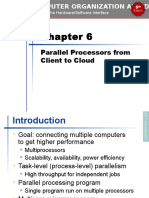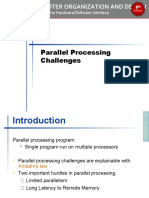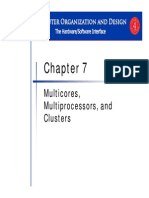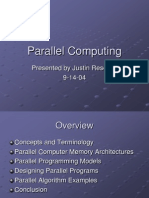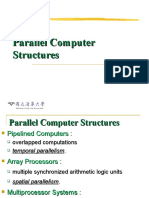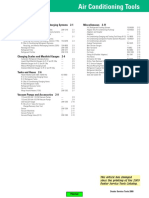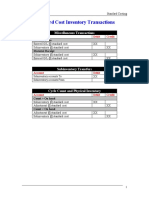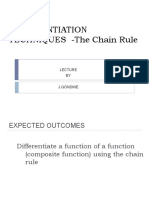COMPUTER
ORGANIZATION
AND
DESIGN
The Hardware/Software Interface
Chapter 6
Parallel Processors from
Client to Cloud
5th
Edition
Goal: connecting multiple computers
to get higher performance
n
n
High throughput for independent jobs
Parallel processing program
n
Multiprocessors
Scalability, availability, power efficiency
Task-level (process-level) parallelism
n
6.1 Introduction
Introduction
Single program run on multiple processors
Multicore microprocessors
n
Chips with multiple processors (cores)
Chapter 6 Parallel Processors from Client to Cloud 2
�Hardware and Software
n
Hardware
n
n
Software
n
n
Serial: e.g., Pentium 4
Parallel: e.g., quad-core Xeon e5345
Sequential: e.g., matrix multiplication
Concurrent: e.g., operating system
Sequential/concurrent software can run on
serial/parallel hardware
n
Challenge: making effective use of parallel
hardware
Chapter 6 Parallel Processors from Client to Cloud 3
�What Weve Already Covered
n
2.11: Parallelism and Instructions
n
3.6: Parallelism and Computer Arithmetic
n
Synchronization
Subword Parallelism
4.10: Parallelism and Advanced
Instruction-Level Parallelism
5.10: Parallelism and Memory
Hierarchies
n
Cache Coherence
Chapter 6 Parallel Processors from Client to Cloud 4
�n
n
Parallel software is the problem
Need to get significant performance
improvement
n
Otherwise, just use a faster uniprocessor,
since its easier!
Difficulties
n
n
n
Partitioning
Coordination
Communications overhead
6.2 The Difficulty of Creating Parallel Processing Programs
Parallel Programming
Chapter 6 Parallel Processors from Client to Cloud 5
�Amdahls Law
n
n
Sequential part can limit speedup
Example: 100 processors, 90 speedup?
n
Tnew = Tparallelizable/100 + Tsequential
1
Speedup =
= 90
(1 Fparallelizable ) + Fparallelizable /100
Solving: Fparallelizable = 0.999
Need sequential part to be 0.1% of original
time
Chapter 6 Parallel Processors from Client to Cloud 6
�Scaling Example
n
Workload: sum of 10 scalars, and 10 10 matrix
sum
n
n
n
Single processor: Time = (10 + 100) tadd
10 processors
n
n
Time = 10 tadd + 100/10 tadd = 20 tadd
Speedup = 110/20 = 5.5 (55% of potential)
100 processors
n
n
Speed up from 10 to 100 processors
Time = 10 tadd + 100/100 tadd = 11 tadd
Speedup = 110/11 = 10 (10% of potential)
Assumes load can be balanced across
processors
Chapter 6 Parallel Processors from Client to Cloud 7
�Scaling Example (cont)
n
n
n
What if matrix size is 100 100?
Single processor: Time = (10 + 10000) tadd
10 processors
n
n
100 processors
n
n
Time = 10 tadd + 10000/10 tadd = 1010 tadd
Speedup = 10010/1010 = 9.9 (99% of potential)
Time = 10 tadd + 10000/100 tadd = 110 tadd
Speedup = 10010/110 = 91 (91% of potential)
Assuming load balanced
Chapter 6 Parallel Processors from Client to Cloud 8
�Strong vs Weak Scaling
n
Strong scaling: problem size fixed
n
As in example
Weak scaling: problem size proportional to
number of processors
n
10 processors, 10 10 matrix
n
100 processors, 32 32 matrix
n
Time = 20 tadd
Time = 10 tadd + 1000/100 tadd = 20 tadd
Constant performance in this example
Chapter 6 Parallel Processors from Client to Cloud 9
An alternate classification
Data Streams
Single
Instruction Single
Streams
Multiple
Multiple
SISD:
Intel Pentium 4
SIMD: SSE
instructions of x86
MISD:
No examples today
MIMD:
Intel Xeon e5345
SPMD: Single Program Multiple Data
n
n
6.3 SISD, MIMD, SIMD, SPMD, and Vector
Instruction and Data Streams
A parallel program on a MIMD computer
Conditional code for different processors
Chapter 6 Parallel Processors from Client to Cloud 10
�Example: DAXPY (Y = a X + Y)
Conventional MIPS code
l.d
$f0,a($sp)
addiu r4,$s0,#512
loop: l.d
$f2,0($s0)
mul.d $f2,$f2,$f0
l.d
$f4,0($s1)
add.d $f4,$f4,$f2
s.d
$f4,0($s1)
addiu $s0,$s0,#8
addiu $s1,$s1,#8
subu $t0,r4,$s0
bne
$t0,$zero,loop
n Vector MIPS code
l.d
$f0,a($sp)
lv
$v1,0($s0)
mulvs.d $v2,$v1,$f0
lv
$v3,0($s1)
addv.d $v4,$v2,$v3
sv
$v4,0($s1)
n
;load scalar a
;upper bound of what to load
;load x(i)
;a x(i)
;load y(i)
;a x(i) + y(i)
;store into y(i)
;increment index to x
;increment index to y
;compute bound
;check if done
;load scalar a
;load vector x
;vector-scalar multiply
;load vector y
;add y to product
;store the result
Chapter 6 Parallel Processors from Client to Cloud 11
�Vector Processors
n
n
Highly pipelined function units
Stream data from/to vector registers to units
n
n
Data collected from memory into registers
Results stored from registers to memory
Example: Vector extension to MIPS
n
n
32 64-element registers (64-bit elements)
Vector instructions
n
n
n
lv, sv: load/store vector
addv.d: add vectors of double
addvs.d: add scalar to each element of vector of double
Significantly reduces instruction-fetch bandwidth
Chapter 6 Parallel Processors from Client to Cloud 12
�Vector vs. Scalar
n
Vector architectures and compilers
Simplify data-parallel programming
n Explicit statement of absence of loop-carried
dependences
n
Reduced checking in hardware
Regular access patterns benefit from
interleaved and burst memory
n Avoid control hazards by avoiding loops
n
More general than ad-hoc media
extensions (such as MMX, SSE)
n
Better match with compiler technology
Chapter 6 Parallel Processors from Client to Cloud 13
�SIMD
n
Operate elementwise on vectors of data
n
E.g., MMX and SSE instructions in x86
n
All processors execute the same
instruction at the same time
n
n
n
n
Multiple data elements in 128-bit wide registers
Each with different data address, etc.
Simplifies synchronization
Reduced instruction control hardware
Works best for highly data-parallel
applications
Chapter 6 Parallel Processors from Client to Cloud 14
�Vector vs. Multimedia Extensions
n
Vector instructions have a variable vector width,
multimedia extensions have a fixed width
Vector instructions support strided access,
multimedia extensions do not
Vector units can be combination of pipelined and
arrayed functional units:
Chapter 6 Parallel Processors from Client to Cloud 15
Performing multiple threads of execution in
parallel
n
n
Fine-grain multithreading
n
n
n
Replicate registers, PC, etc.
Fast switching between threads
6.4 Hardware Multithreading
Multithreading
Switch threads after each cycle
Interleave instruction execution
If one thread stalls, others are executed
Coarse-grain multithreading
n
n
Only switch on long stall (e.g., L2-cache miss)
Simplifies hardware, but doesnt hide short stalls
(eg, data hazards)
Chapter 6 Parallel Processors from Client to Cloud 16
�Simultaneous Multithreading
n
In multiple-issue dynamically scheduled
processor
Schedule instructions from multiple threads
n Instructions from independent threads execute
when function units are available
n Within threads, dependencies handled by
scheduling and register renaming
n
Example: Intel Pentium-4 HT
n
Two threads: duplicated registers, shared
function units and caches
Chapter 6 Parallel Processors from Client to Cloud 17
�Multithreading Example
Chapter 6 Parallel Processors from Client to Cloud 18
�Future of Multithreading
n
n
Will it survive? In what form?
Power considerations simplified
microarchitectures
n
Tolerating cache-miss latency
n
Simpler forms of multithreading
Thread switch may be most effective
Multiple simple cores might share
resources more effectively
Chapter 6 Parallel Processors from Client to Cloud 19
SMP: shared memory multiprocessor
n
n
n
Hardware provides single physical
address space for all processors
Synchronize shared variables using locks
Memory access time
n
UMA (uniform) vs. NUMA (nonuniform)
6.5 Multicore and Other Shared Memory Multiprocessors
Shared Memory
Chapter 6 Parallel Processors from Client to Cloud 20
�Example: Sum Reduction
n
Sum 100,000 numbers on 100 processor UMA
n
n
n
Each processor has ID: 0 Pn 99
Partition 1000 numbers per processor
Initial summation on each processor
sum[Pn] = 0;
for (i = 1000*Pn;
i < 1000*(Pn+1); i = i + 1)
sum[Pn] = sum[Pn] + A[i];
Now need to add these partial sums
n
n
n
Reduction: divide and conquer
Half the processors add pairs, then quarter,
Need to synchronize between reduction steps
Chapter 6 Parallel Processors from Client to Cloud 21
�Example: Sum Reduction
half = 100;
repeat
synch();
if (half%2 != 0 && Pn == 0)
sum[0] = sum[0] + sum[half-1];
/* Conditional sum needed when half is odd;
Processor0 gets missing element */
half = half/2; /* dividing line on who sums */
if (Pn < half) sum[Pn] = sum[Pn] + sum[Pn+half];
until (half == 1);
Chapter 6 Parallel Processors from Client to Cloud 22
Early video cards
n
3D graphics processing
n
n
n
Frame buffer memory with address generation for
video output
Originally high-end computers (e.g., SGI)
Moores Law lower cost, higher density
3D graphics cards for PCs and game consoles
Graphics Processing Units
n
n
6.6 Introduction to Graphics Processing Units
History of GPUs
Processors oriented to 3D graphics tasks
Vertex/pixel processing, shading, texture mapping,
rasterization
Chapter 6 Parallel Processors from Client to Cloud 23
�Graphics in the System
Chapter 6 Parallel Processors from Client to Cloud 24
�GPU Architectures
n
Processing is highly data-parallel
n
n
GPUs are highly multithreaded
Use thread switching to hide memory latency
n
Graphics memory is wide and high-bandwidth
Trend toward general purpose GPUs
n
n
Less reliance on multi-level caches
Heterogeneous CPU/GPU systems
CPU for sequential code, GPU for parallel code
Programming languages/APIs
n
n
DirectX, OpenGL
C for Graphics (Cg), High Level Shader Language
(HLSL)
Compute Unified Device Architecture (CUDA)
Chapter 6 Parallel Processors from Client to Cloud 25
�Example: NVIDIA Tesla
Streaming
multiprocessor
8 Streaming
processors
Chapter 6 Parallel Processors from Client to Cloud 26
�Example: NVIDIA Tesla
n
Streaming Processors
n
n
Single-precision FP and integer units
Each SP is fine-grained multithreaded
Warp: group of 32 threads
n
Executed in parallel,
SIMD style
n
8 SPs
4 clock cycles
Hardware contexts
for 24 warps
n
Registers, PCs,
Chapter 6 Parallel Processors from Client to Cloud 27
�Classifying GPUs
n
Dont fit nicely into SIMD/MIMD model
n
Conditional execution in a thread allows an
illusion of MIMD
n
n
But with performance degredation
Need to write general purpose code with care
Instruction-Level
Parallelism
Data-Level
Parallelism
Static: Discovered
at Compile Time
Dynamic: Discovered
at Runtime
VLIW
Superscalar
SIMD or Vector
Tesla Multiprocessor
Chapter 6 Parallel Processors from Client to Cloud 28
�GPU Memory Structures
Chapter 6 Parallel Processors from Client to Cloud 29
�Putting GPUs into Perspective
Feature
Multicore with SIMD
GPU
SIMD processors
4 to 8
8 to 16
SIMD lanes/processor
2 to 4
8 to 16
Multithreading hardware support for
SIMD threads
2 to 4
16 to 32
2:1
2:1
Largest cache size
8 MB
0.75 MB
Size of memory address
64-bit
64-bit
8 GB to 256 GB
4 GB to 6 GB
Memory protection at level of page
Yes
Yes
Demand paging
Yes
No
Integrated scalar processor/SIMD
processor
Yes
No
Cache coherent
Yes
No
Typical ratio of single precision to
double-precision performance
Size of main memory
Chapter 6 Parallel Processors from Client to Cloud 30
�Guide to GPU Terms
Chapter 6 Parallel Processors from Client to Cloud 31
Each processor has private physical
address space
Hardware sends/receives messages
between processors
6.7 Clusters, WSC, and Other Message-Passing MPs
Message Passing
Chapter 6 Parallel Processors from Client to Cloud 32
�Loosely Coupled Clusters
n
Network of independent computers
n
n
Each has private memory and OS
Connected using I/O system
n
Suitable for applications with independent tasks
n
n
n
E.g., Ethernet/switch, Internet
Web servers, databases, simulations,
High availability, scalable, affordable
Problems
n
n
Administration cost (prefer virtual machines)
Low interconnect bandwidth
n
c.f. processor/memory bandwidth on an SMP
Chapter 6 Parallel Processors from Client to Cloud 33
�Sum Reduction (Again)
n
n
Sum 100,000 on 100 processors
First distribute 100 numbers to each
n
The do partial sums
sum = 0;
for (i = 0; i<1000; i = i + 1)
sum = sum + AN[i];
Reduction
Half the processors send, other half receive
and add
n The quarter send, quarter receive and add,
n
Chapter 6 Parallel Processors from Client to Cloud 34
�Sum Reduction (Again)
n
Given send() and receive() operations
limit = 100; half = 100;/* 100 processors */
repeat
half = (half+1)/2; /* send vs. receive
dividing line */
if (Pn >= half && Pn < limit)
send(Pn - half, sum);
if (Pn < (limit/2))
sum = sum + receive();
limit = half; /* upper limit of senders */
until (half == 1); /* exit with final sum */
n
n
Send/receive also provide synchronization
Assumes send/receive take similar time to addition
Chapter 6 Parallel Processors from Client to Cloud 35
�Grid Computing
n
Separate computers interconnected by
long-haul networks
n
n
E.g., Internet connections
Work units farmed out, results sent back
Can make use of idle time on PCs
n
E.g., SETI@home, World Community Grid
Chapter 6 Parallel Processors from Client to Cloud 36
Network topologies
n
Arrangements of processors, switches, and links
Bus
Ring
N-cube (N = 3)
2D Mesh
6.8 Introduction to Multiprocessor Network Topologies
Interconnection Networks
Fully connected
Chapter 6 Parallel Processors from Client to Cloud 37
�Multistage Networks
Chapter 6 Parallel Processors from Client to Cloud 38
�Network Characteristics
n
Performance
n
n
Latency per message (unloaded network)
Throughput
n
n
n
n
n
n
Link bandwidth
Total network bandwidth
Bisection bandwidth
Congestion delays (depending on traffic)
Cost
Power
Routability in silicon
Chapter 6 Parallel Processors from Client to Cloud 39
�n
n
Linpack: matrix linear algebra
SPECrate: parallel run of SPEC CPU programs
n
SPLASH: Stanford Parallel Applications for
Shared Memory
n
Mix of kernels and applications, strong scaling
NAS (NASA Advanced Supercomputing) suite
n
Job-level parallelism
computational fluid dynamics kernels
PARSEC (Princeton Application Repository for
Shared Memory Computers) suite
n
Multithreaded applications using Pthreads and
OpenMP
6.10 Multiprocessor Benchmarks and Performance Models
Parallel Benchmarks
Chapter 6 Parallel Processors from Client to Cloud 40
�Code or Applications?
n
Traditional benchmarks
n
Fixed code and data sets
Parallel programming is evolving
Should algorithms, programming languages,
and tools be part of the system?
n Compare systems, provided they implement a
given application
n E.g., Linpack, Berkeley Design Patterns
n
Would foster innovation in approaches to
parallelism
Chapter 6 Parallel Processors from Client to Cloud 41
�Modeling Performance
n
Assume performance metric of interest is
achievable GFLOPs/sec
n
Arithmetic intensity of a kernel
n
Measured using computational kernels from
Berkeley Design Patterns
FLOPs per byte of memory accessed
For a given computer, determine
Peak GFLOPS (from data sheet)
n Peak memory bytes/sec (using Stream
benchmark)
n
Chapter 6 Parallel Processors from Client to Cloud 42
�Roofline Diagram
Attainable GPLOPs/sec
= Max ( Peak Memory BW Arithmetic Intensity, Peak FP Performance )
Chapter 6 Parallel Processors from Client to Cloud 43
�Comparing Systems
n
Example: Opteron X2 vs. Opteron X4
n
2-core vs. 4-core, 2 FP performance/core, 2.2GHz
vs. 2.3GHz
Same memory system
n
To get higher performance
on X4 than X2
n
n
Need high arithmetic intensity
Or working set must fit in X4s
2MB L-3 cache
Chapter 6 Parallel Processors from Client to Cloud 44
�Optimizing Performance
n
Optimize FP performance
Balance adds & multiplies
n Improve superscalar ILP
and use of SIMD
instructions
n
Optimize memory usage
n
Software prefetch
n
Avoid load stalls
Memory affinity
n
Avoid non-local data
accesses
Chapter 6 Parallel Processors from Client to Cloud 45
�Optimizing Performance
n
Choice of optimization depends on
arithmetic intensity of code
n
Arithmetic intensity is
not always fixed
May scale with
problem size
n Caching reduces
memory accesses
n
Increases arithmetic
intensity
Chapter 6 Parallel Processors from Client to Cloud 46
�6.11 Real Stuff: Benchmarking and Rooflines i7 vs. Tesla
i7-960 vs. NVIDIA Tesla 280/480
Chapter 6 Parallel Processors from Client to Cloud 47
�Rooflines
Chapter 6 Parallel Processors from Client to Cloud 48
�Benchmarks
Chapter 6 Parallel Processors from Client to Cloud 49
�Performance Summary
n
GPU (480) has 4.4 X the memory bandwidth
n
GPU has 13.1 X the single precision throughout, 2.5 X
the double precision throughput
n
Benefits memory bound kernels
Benefits FP compute bound kernels
CPU cache prevents some kernels from becoming
memory bound when they otherwise would on GPU
GPUs offer scatter-gather, which assists with kernels
with strided data
Lack of synchronization and memory consistency support
on GPU limits performance for some kernels
Chapter 6 Parallel Processors from Client to Cloud 50
Use OpenMP:
void dgemm (int n, double* A, double* B, double* C)
{
#pragma omp parallel for
for ( int sj = 0; sj < n; sj += BLOCKSIZE )
for ( int si = 0; si < n; si += BLOCKSIZE )
for ( int sk = 0; sk < n; sk += BLOCKSIZE )
do_block(n, si, sj, sk, A, B, C);
}
6.12 Going Faster: Multiple Processors and Matrix Multiply
Multi-threading DGEMM
Chapter 6 Parallel Processors from Client to Cloud 51
�Multithreaded DGEMM
Chapter 6 Parallel Processors from Client to Cloud 52
�Multithreaded DGEMM
Chapter 6 Parallel Processors from Client to Cloud 53
Amdahls Law doesnt apply to parallel
computers
n
n
Since we can achieve linear speedup
But only on applications with weak scaling
6.13 Fallacies and Pitfalls
Fallacies
Peak performance tracks observed
performance
n
n
n
Marketers like this approach!
But compare Xeon with others in example
Need to be aware of bottlenecks
Chapter 6 Parallel Processors from Client to Cloud 54
�Pitfalls
n
Not developing the software to take
account of a multiprocessor architecture
n
Example: using a single lock for a shared
composite resource
n
Serializes accesses, even if they could be done in
parallel
Use finer-granularity locking
Chapter 6 Parallel Processors from Client to Cloud 55
Goal: higher performance by using multiple
processors
Difficulties
n
n
Developing parallel software
Devising appropriate architectures
6.14 Concluding Remarks
Concluding Remarks
SaaS importance is growing and clusters are a
good match
Performance per dollar and performance per
Joule drive both mobile and WSC
Chapter 6 Parallel Processors from Client to Cloud 56
�Concluding Remarks (cont)
n
SIMD and vector
operations match
multimedia applications
and are easy to
program
Chapter 6 Parallel Processors from Client to Cloud 57
